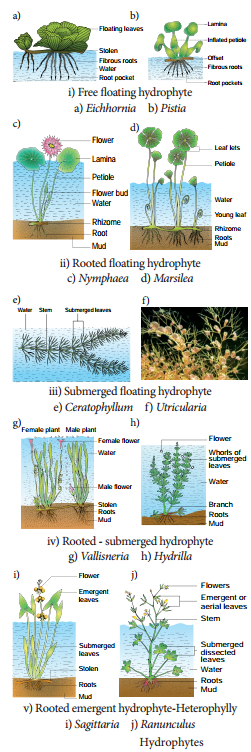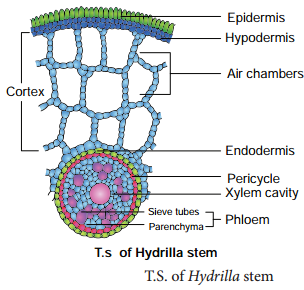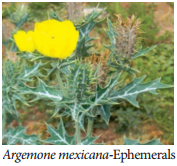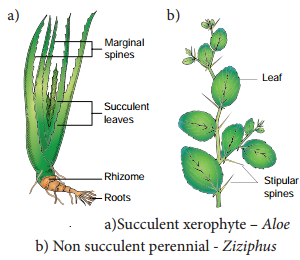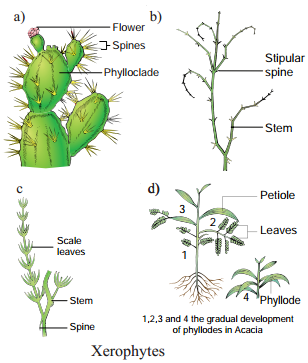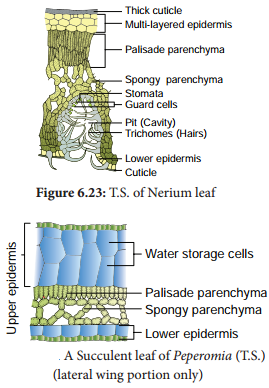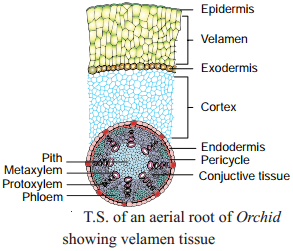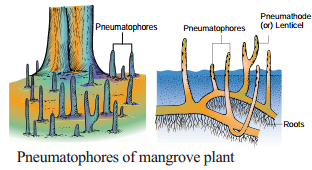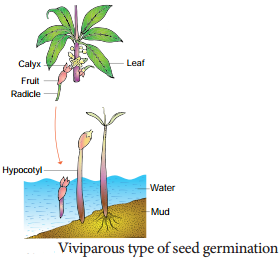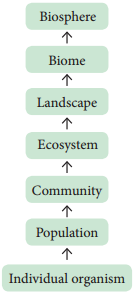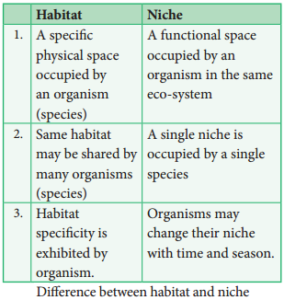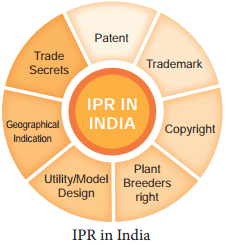Learninsta presents the core concepts of Biology with high-quality research papers and topical review articles.
Ecological Factors | Climatic Factors | Edaphic Factors | Topographic Factors | Biotic Factors
Many organisms, co-exist in an environment. The environment (surrounding) includes physical, chemical and biological components. When a component surrounding an organism affects the life of an organism, it becomes a factor.
All such factors together are called environmental factors or ecological factors. These factors can be classified into living (biotic) and non-living (abiotic) which make the environment of an organism. However the ecological factors are meaningfully grouped into four classes, which are as follows:
- Climatic factors
- Edaphic factors
- Topographic factors
- Biotic factors
We will discuss the above factors in a concise manner.
Climatic Factors
Climate is one of the important natural factors controlling the plant life. The climatic factors includes light, temperature, water, wind and fire.
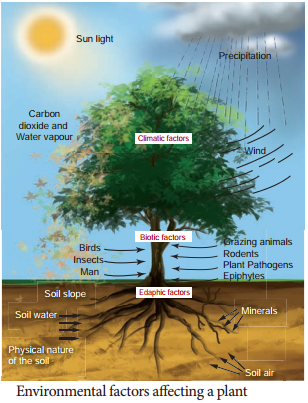
a. Light
Light is a well known factor needed for the basic physiological processes of plants, such as photosynthesis, transpiration, seed germination and flowering. The portion of the sunlight which can be resolved by the human eye is called visible light.
The visible part of light is madeup of wavelength from about 400 nm (violet) to 700 nm (red). The rate of photosynthesis is maximum at blue (400 – 500 nm) and red (600 – 700 nm). The green (500 – 600 nm) wave length of spectrum is less strongly absorbed by plants.
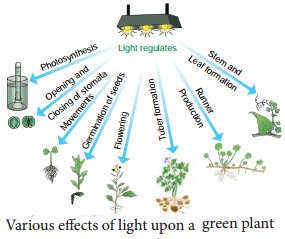
Based on the tolerance to intensities of light, the plants are divided into two types. They are:-
- Heliophytes – Light loving plants. Example: Angiosperms.
- Sciophytes – Shade loving plants. Example: Bryophytes and Pteridophytes.
b. Temperature
Temperature is one of the important factors which affect almost all the metabolic activities of an organism. Every physiological process in an organism requires an optimum temperature at which it shows the maximum metabolic rate. Three limits of temperature can be recognized for any organism. They are
- Minimum temperature – Physiological activities are lowest.
- Optimum temperature – Physiological activities are maximum.
- Maximum temperature – Physiological activities will stop.
Based on the temperature prevailing in an area, Raunkiaer classified the world’s vegetation into the following four types. They are megatherms, mesotherms, microtherms and hekistotherms. In thermal springs and deep sea hydrothermal vents the average temperature exceed 100°c. Based on the range of thermal tolerance, organisms are divided into two types.
1. Eurythermal:
Organisms which can tolerate a wide range of temperature fluctuations.
Example: Zostera (A marine Angiosperm) and Artemisia tridentata.
2. Stenothermal:
Organisms which can tolerate only small range of temperature variations. Example: Mango and Palm (Terrestrial Angiosperms). Mango plant does not grow in temperate countries like Canada and Germany.
Thermal Stratifiation:
It is usually found in aquatic habitat. The change in the temperature profile with increasing depth in a water body is called thermal stratifiation. There are three levels of thermal stratifiations.
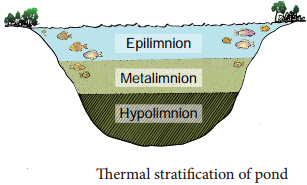
- Epilimnion – The upper layer of warmer water.
- Metalimnion – The middle layer with a zone of gradual decrease in temperature.
- Hypolimnion – The bottom layer of colder water.
Temperature based zonation
Variations in latitude and altitude do affect the temperature and the vegetation on the earth surface. The latitudinal and altitudinal zonation of vegetation is illustrated below:
Latitude:
Latitude is an angle which ranges from 0° at the equator to 90° at the place.
Altitude:
How high a place is located above the sea level is called the altitude of the place.
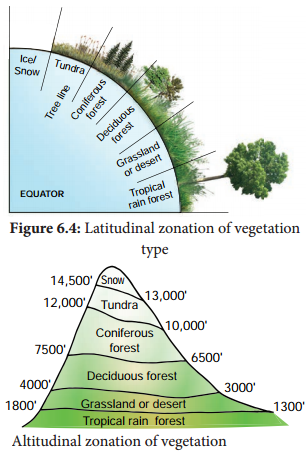
Timber line/Tree line:
It is an imaginary line in a mountain or higher areas of land that marks the level above which trees do not grow. The altitudinal limit of normal tree growth is about 3000 to 4000m.
Effects of temperature
The following physiological processes are inflenced by temperature:
- Temperature affcts the enzymatic action of all the bio-chemical reactions in a plant body.
- It inflences CO2 and O2 solubility in the biological systems. Increases respiration and stimulates growth of seedlings.
- Low temperature with high humidity can cause spread of diseases in plants.
- The varying temperature with moisture determines the distribution of the vegetation types.
c. Water
Water is one of the most important climatic factors. It affects the vital processes of all living organisms. It is believed that even life had originated only in water during the evolution of Earth. Water covers more than 70% of the earth’s surface. In nature, water is available to plants in three ways. They are atmospheric moisture, precipitation and soil water.
The productivity and distribution of plants depend upon the availability of water. Further the quality of water is also important especially for the aquatic organisms. The total amount of water salinity in different water bodies are:
- 5% in inland water (Fresh water)
- 30 – 35% in sea water and
- More than 100% in hypersaline water (Lagoons) Based on the range of tolerance of salinity, organisms are divided into two types.
1. Euryhaline:
Organisms which can live in water with wide range of salinity. Examples: Marine algae and marina angiosperms
2. Stenohaline:
Organisms which can withstand only small range of salinity. Example: Plants of estuaries.
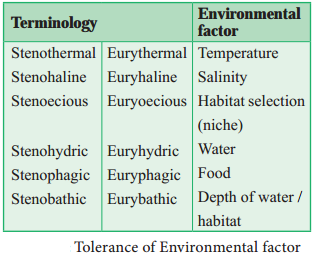
Examples of tolerance to toxicity
(i) Soyabean and tomato manage to tolerate presence of cadmium poisoning by isolating cadmium and storing into few group of cells and prevent cadmium affcting other cells.
(ii) Rice and Eichhornia (water hyacinth) tolerate cadmium by binding it to their proteins. These plants otherwise can also be used to remove cadmium from contaminated soil, this is known as Phytoremediation.
d. Wind
Air in motion is called wind. It is also a vital ecological factor. The atmospheric air contains a number of gases, particles and other constituents. The composition of gases in atmosphere is as follows: Nitrogen – 78% , Oxygen – 21%, Carbon-di-oxide – 0.03%, Argon and other gases – 0.93%. The other components of wind are water vapour, gaseous pollutants, dust, smoke particles, microorganisms, pollen grains, spores, etc. Anemometer is the instrument used to measure the speed of wind.
Effects of wind
- Wind is an important factor for the formation of rain
- Causes wave formation in lakes and ocean, promotes aeration of water
- Strong wind causes soil erosion and reduces soil fertility
- Increases the rate of transpiration
- Helps in pollination in anemophilous plants
- It also helps in dispersal of many fruits, seeds, spores, etc.
- Strong wind may cause up-rooting of big trees
- Unidirectional wind stimulates the development of flag forms in trees.
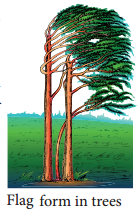
e. Fire
Fire is an exothermic factor caused due to the chemical process of combustion, releasing heat and light. It is mostly man-made and sometimes develops naturally due to the friction between the tree surfaces. Fire is generally divided into
- Ground fie – Which is flameless and subterranean.
- Surface fie – Which consumes the herbs and shrubs.
- Crown fie – Which burns the forest canopy.
Effects of fie
- Fire has a direct lethal effect on plants
- Burning scars are the suitable places for the entry of parasitic fungi and insects
- It brings out the alteration of light, rainfall, nutrient cycle, fertility of soil, pH, soil flora and fauna
- Some fungi which grow in soil of burnt areas called pyrophilous. Example: Pyronema conflens.
Edaphic factors
Edaphic factors, the abiotic factors related to soil, include the physical and chemical composition of the soil formed in a particular area. The study of soils is called Pedology.
The soil
Soil is the weathered superfiial layer of the Earth in which plants can grow. It is a complex composite mass consisting of soil constituents, soil water, soil air and soil organisms, etc.
Soil formation
Soil originates from rocks and develops gradually at different rates, depending upon the ecological and climatic conditions. Soil formation is initiated by the weathering process. Biological weathering takes place when organisms like bacteria, fungi, lichens and plants help in the breakdown of rocks through the production of acids and certain chemical substances.
Soil types
Based on soil formation (pedogenesis), the soils are divided into
- Residual soils – These are soils formed by weathering and pedogenesis of the rock.
- Transported soils – These are transported by various agencies.
The important edaphic factors which affect vegetation are as follows:
1. Soil moisture:
Plants absorbs rain water and moisture directly from the air
2. Soil water:
Soil water is more important than any other ecological factors affecting the distribution of plants. Rain is the main source of soil water. Capillary water held between pore spaces of soil particles and angles between them is the most important form of water available to the plants.
3. Soil reactions:
Soil may be acidic or alkaline or neutral in their reaction. pH value of the soil solution determines the availability of plant nutrients. The best pH range of the soil for cultivation of crop plants is 5.5 to 6.8.
4. Soil nutrients:
Soil fertility and productivity is the ability of soil to provide all essential plant nutrients such as minerals and organic nutrients in the form of ions.
5. Soil temperature:
Soil temperature of an area plays an important role in determining the geographical distribution of plants. Low temperature reduces use of water and solute absorption by roots.
6. Soil atmosphere:
The spaces left between soil particles are called pore spaces which contains oxygen and carbon-di-oxide.
7. Soil organisms:
Many organisms existing in the soil like bacteria, fungi, algae, protozoans, nematodes, insects, earthworms, etc. are called soil organisms.
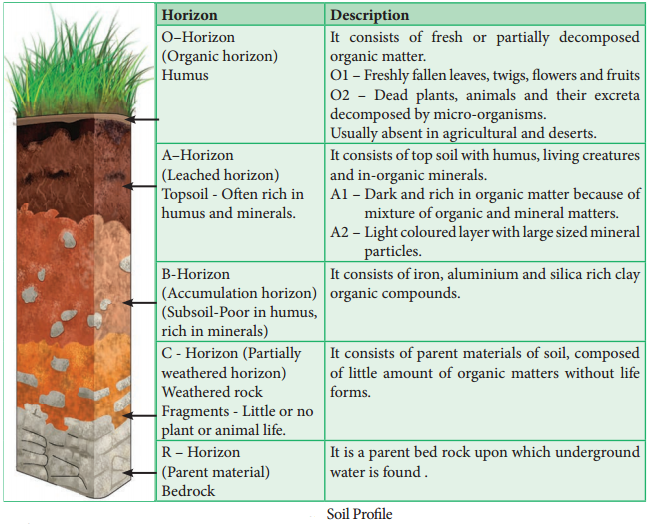
Soil Profie
Soil is commonly stratified into horizons at different depth. These layers differ in their physical, chemical and biological properties. This succession of super-imposed horizons is called soil profie.
Types of soil particles
Based on the relative proportion of soil particles, four types of soil are recognized.
Loamy soil is ideal soil for cultivation. It consists of 70% sand and 30% clay or silt or both. It ensures good retention and proper drainage of water. Th porosity of soil provides adequate aeration and allows the penetration of roots.
Based on the water retention, aeration and mineral contents of soil, the distribution of vegetation is divided into following types.
- Halophytes: Plants living in saline soils
- Psammophytes: Plants living in sandy soils
- Lithophytes: Plants living on rocky surface
- Chasmophytes: Plants living in rocky crevices
- Cryptophytes: Plants living below the soil surface
- Cryophytes: Plants living on surface of ice
- Oxylophytes: Plants living in acidic soil
- Calciphytes: Plants living in calcium rich alkaline soil
Topographic factors
The surface features of earth are called topography. Topographic influence on the climate of any area is determined by the interaction of solar radiation, temperature, humidity, rainfall, latitude and altitude. It affects the vegetation through climatic variations in small areas (micro climate) and even changes the soil conditions. Topographic factors include latitude, altitude, direction of mountain, steepness of mountain etc.
a. Latitudes and altitudes
Latitudes represent distance from the equator. Temperature values are maximum at the equator and decrease gradually towards poles. Different types of vegetation occur from equator to poles which are illustrated below.
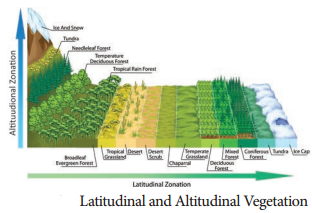
Height above the sea level forms the altitude. At high altitudes, the velocity of wind remains high, temperature and air pressure decrease while humidity and intensity of light increases. Due to these factors, vegetation at different altitudes varies, showing distinct zonation.
b. Direction of Mountain
North and south faces of mountain or hill possess different types of flra and fauna because they differ in their humidity, rainfall, light intensity, light duration and temperature regions.
Ecotone – The transition zone between two ecosystems.
Example: The border between forest and grassland.
Edge effect – Spices found in ecotone areas are unique due to the effect of the two habitats. This is called edge effect. Example: Owl in the ecotone area between forest and grassland.
The two faces of the mountain or hill receive different amount of solar radiation, wind action and rain. Of these two faces, the windward region possesses good vegetation due to heavy rains and the leeward region possesses poor vegetation due to rain shadows (rain defit).
Similarly in the soil of aquatic bodies like ponds the center and edge possess different depth of water due to soil slope and different wave actions in the water body. Therefore, different parts of the same area may possess different species of organisms.
c. Steepness of the mountain
The steepness of the mountain or hill allows the rain to run off As a result the loss of water causes water deficit and quick erosion of the top soil resulting in poor vegetation. On the other hand, the plains and valley are rich in vegetation due to the slow drain of surface water and better retention of water in the soil.
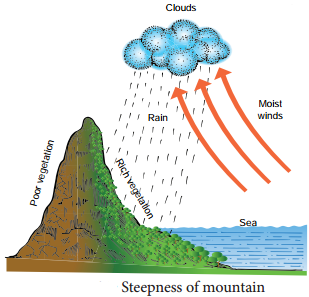
Biotic factors
The interactions among living organisms such as plants and animals are called biotic factors, which may cause marked effects upon vegetation. The effcts may be direct and indirect and modifies the environment. The plants mostly which lives together in a community and influence one another. Similarly, animals in association with plants also affect the plant life in one or several ways.
The different interactions among them can be classified into following two types they are positive interaction and negative interaction Positive interactions When one or both the participating species are benefied, it is positive interaction. Examples; Mutualism and Commensalism.
a. Mutualism:
It is an interaction between two species of organisms in which both are benefited from the obligate association. The following are common examples of mutualism.
Nitrogen fiation
Rhizobium (Bacterium) forms nodules in the roots of leguminous plants and lives symbiotically. The Rhizobium obtains food from leguminous plant and in turn fies atmospheric nitrogen into nitrate, making it available to host plants.
Other examples:
- Water fern (Azolla) and Nitrogen fixing Cyanobacterium (Anabaena).
- Anabaena present in coralloid roots of Cycas. (Gymnosperm)
- Cyanobacterium (Nostoc) found in the thalloid body of Anthoceros. (Bryophytes)
- Wasps present in fruits of fig.
- Lichen is a mutual association of an alga and a fungus.
- Roots of terrestrial plants and fungal hyphae – Mycorrhiza
b. Commensalism:
It is an interaction between two organisms in which one is benefitted and the other is neither benefited nor harmed. The species that derives benefit is called the commensal, while the other species is called the host. The common examples of commensalism are listed below:
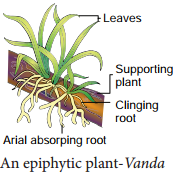
Epiphytes
The plants which are found growing on other plants without harming them are called epiphytes. They are commonly found in tropical rain forest.
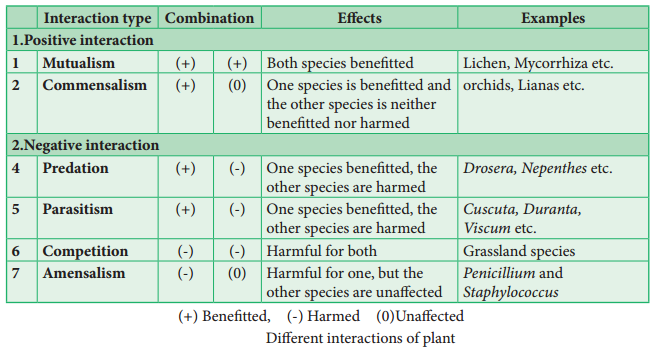
The epiphytic higher plant (Orchid) gets its nutrients and water from the atmosphere with the help of the hygroscopic roots which contain special type of spongy tissue called Velamen. It prepares its own food and does not depend on the host. Using the host plant only they support and does not harm it in any way.
- Many orchids, ferns, lianas, hanging mosses, Peperomia, money plant and Usnea (Lichen) are some of the examples of epiphytes.
- Spanish Moss – Tillandsia grows on the bark of Oak and Pine trees.
Negative interactions
When one of the interacting species is benefitted and the other is harmed, it is called negative interaction. Examples: predation, parasitism, competition and amensalism.
a. Predation:
It is an interaction between two species, one of which captures, kills and eats up the other. The species which kills is called a predator and the species which is killed is called a prey. The predator is benefitted while the prey is harmed.
Examples:
A number of plants like Drosera (Sun dew plant), Nepenthes (Pitcher Plant), Dionaea (Venus fly trap), Utricularia (Bladder wort) and Sarracenia are predators which consume insects and other small animals for their food as a source of nitrogen. They are also called as insectivorous plants.
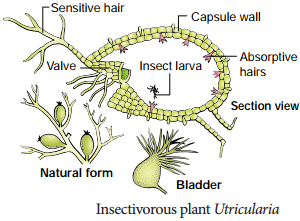
Many herbivores are predators. Cattles, Camels, Goats etc., frequently browse on the tender shoots of herbs, shrubs and trees. Generally annuals suffer more than the perennials. Grazing and browsing may cause remarkable changes in vegetation. Nearly 25 percent of all insects are known as phytophagous (feeds on plant sap and other parts of plant)
Many defense mechanisms are evolved to avoid their predations by plants. Examples: Calotropis produces highly poisonous cardiac glycosides, Tobacco produces nicotine, coffe plants produce caffine, Cinchona plant produces quinine. Throns of Bougainvillea, spines of Opuntia, and latex of cacti also protect them from predators.
b. Parasitism:
It is an interaction between two different species in which the smaller partner (parasite) obtains food from the larger partner (host or plant). So the parasitic species is benefied while the host species is harmed. Based on the host-parasite relationship, parasitism is classified into two types they are holoparasite and hemiparasite.
Holoparasites
The organisms which are dependent upon the host plants for their entire nutrition are called Holoparasites. They are also called total parasites.
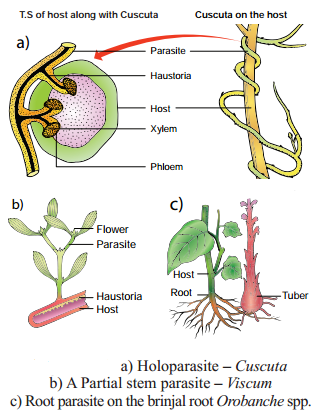
Examples:
- Cuscuta is a total stem parasite of the host plant Acacia, Duranta and many other plants. Cuscuta even gets flower inducing hormone from its host plant.
- Balanophora, Orobanche and Rafflia are the total root parasites found on higher plants.
Hemiparasites
The organisms which derive only water and minerals from their host plant while synthesizing their own food by photosynthesis are called Hemiparasites. They are also called partial parasites.
Examples:
- Viscum and Loranthus are partial stem parasites.
- Santalum (Sandal Wood) is a partial root parasite.
The parasitic plants produce the haustorial roots inside the host plant to absorb nutrients from the vascular tissues of host plants.
c. Competition:
It is an interaction between two organisms or species in which both the organisms or species are harmed. Competition is the severest in population that has irregular distribution. Competition is classified into intraspecific and interspecific.
1. Intraspecific competition:
It is an interaction between individuals of the same species. This competition is very severe because all the members of species have similar requirements of food, habitat, pollination etc. and they also have similar adaptations to fulfill their needs.
2. Interspecific competition:
It is an interaction between individuals of different species. In grassland, many species of grasses grow well as there is little competition when enough nutrients and water is available.
During drought shortage of water occurs. A life and death competition starts among the different species of grass lands. Survival in both these competitions is determined by the quantity of nutrients, availability of water and migration to new areas.
Different species of herbivores, larvae and grass hopper competing for fodder or forage plants. Trees, shrubs and herbs in a forest struggle for sunlight, water and nutrients and also for pollination and dispersal of fruits and seeds. The Utricularia (Bladderwort) competes with tiny fishes for small crustaceans and insects.
d. Amensalism:
It is an interspecific interaction in which one species is inhibited while the other species is neither benefited nor harmed. The inhibition is achieved by the secretion of certain chemicals called allelopathic substances. Amensalism is also called antibiosis.
- Penicillium notatum produces penicillin to inhibit the growth of a variety of bacteria especially Staphylococcus.
- Trichoderma inhibits the growth of fungus Aspergillus.
- Roots and hulls of Black Walnut Juglans nigra secretes an alkaloid Juglone which inhibits the growth of seedlings of Apple, Tomato and Alfalfa around it.
Interspecific interactions / Co-evolutionary dynamics
i. Mimicry:
It is a phenomenon in which living organism modifis its form, appearance, structure or behaviour and looks like another living organism as a self defence and increases the chance of its survival. Floral mimicry is for usually inviting pollinators but animal mimicry is often protective. Mimicry is a result of evolutionary signifiance due to shape and sudden heritable mutation and preservation by natural selection.
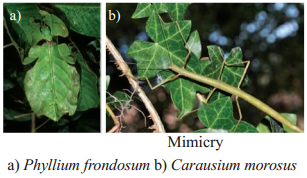
Example:
- The plant, Ophrys an orchid, the flower looks like a female insect to attract the male insect to get pollinated by the male insect and it is otherwise called ‘floral mimicry’.
- Carausium morosus – stick insect or walking stick. It is a protective mimicry.
- Phyllium frondosum – leaf insect, another example of protective mimicry.
ii. Myrmecophily:
Sometimes, ants take their shelter on some trees such as Mango, Litchi, Jamun, Acacia etc. These ants act as body guards of the plants against any disturbing agent and the plants in turn provide food and shelter to these ants. This phenomenon is known as Myrmecophily. Example: Acacia and acacia ants.
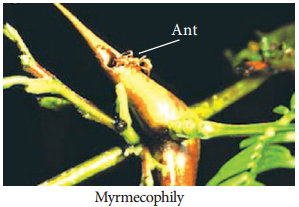
iii. Co-evolution:
The interaction between organisms, when continues for generations, involves reciprocal changes in genetic and morphological characters of both organisms. This type of evolution is called Co-evolution. It is a kind of co-adaptation and mutual change among interactive species. Examples:
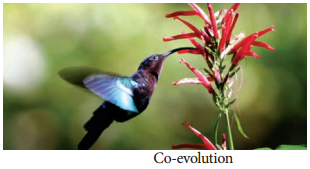
Corolla length and proboscis length of butterfles and moths (Habenaria and Moth).
- Bird’s beak shape and flower shape and size.
- More examples: Horn bills and birds of Scrub jungles, Slit size of pollinia of Apocynaceae members and leg size of insects.
